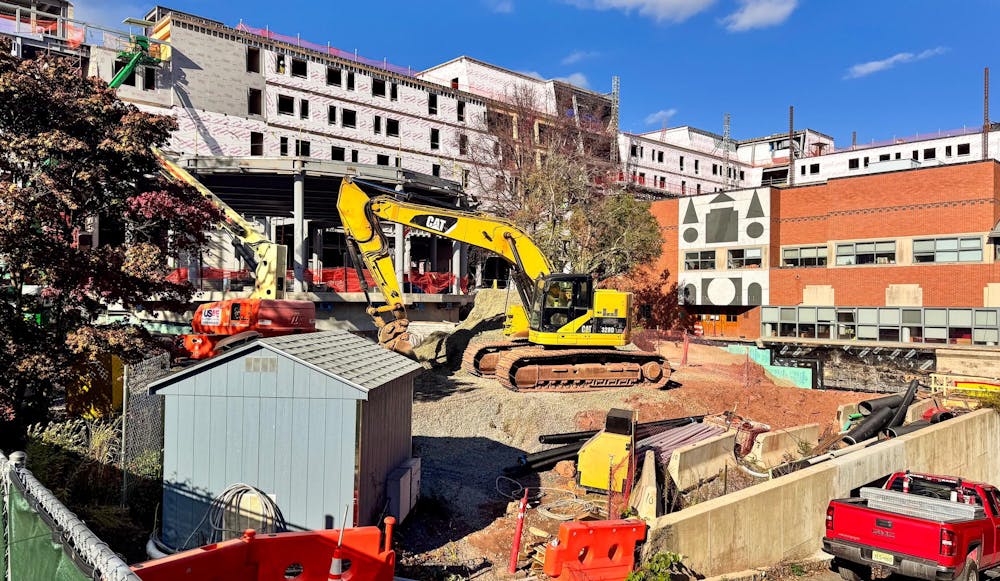In 2023, half of residential rooms were next to active construction sites. Now that the art museum is open and Dillon Gym construction is done, many fewer rooms abut campus construction; however, the Hobson College site is still undergoing construction next to five upperclass and Butler College dorms.
For current Princeton students, it’s hard to imagine the space between Elm Drive and Frist Campus Center as anything other than the construction site for Hobson College, Princeton’s newest residential college.
This semester, The Daily Princetonian investigated how loud the Hobson construction site is by measuring noise levels in locations outside of the five dorm buildings closest to it: Walker Hall, Cuyler Hall, Patton Hall, Yoseloff Hall, and 1976 Hall. Walker, Cuyler, and Patton are all upperclass dorms, while Yoseloff and 1976 are Butler College residence halls.
We measured the noise levels with a decibel (dB) meter standing next to each building at the face closest to construction for around 30 seconds between 8 a.m. and 8:30 a.m. every weekday for two weeks. Data was collected at each hall as recorders walked from building to building along the route, stopping at each building to take measurements.
Most weekdays, the construction site is active from around 7:30 a.m. to 5 p.m. Though it’s hard to see beyond the green-tarp-covered fences that border the site, students have noted the disruptive noise during the completion of the most recent construction project in the same area: Frist Health Center.
For students who live nearby or find themselves walking past the construction site, it can often be a source of discomfort due to the sounds of reversing trucks and the movement of heavy machinery or tools.
“It was definitely hard to get used to for the first month of the school year,” said Georgia Martin ’27, a Walker Hall resident. “I would wake up ridiculously early … Even now that I’m more used to it, if it’s particularly loud, I’ll still get woken up early … a lot of the time it’s just kind of annoying to be in my own dorm room.”
In the morning, the noise outside of all the dorms measured varied from 60 dB to 80 dB on average. Cuyler Hall, which is not directly adjacent to a construction, was almost always the quietest, and Patton and Walker, which are directly next to the construction, were the loudest. The noise outside of Patton was significantly louder than the others, on average 2 to 18 dB louder than the second loudest location.
These negative effects are especially impactful in upperclass housing without air conditioning, as during the warmer months, students frequently open their windows to cool off.
“I think it was way worse at the start, because the windows were open,” Aly Rashid ’26, a Patton Hall resident, told the ‘Prince.’ “When the trucks come in, that’s the worst — the sound of them backing up. You can't really adjust to it, but it’s better now in the winter.”
From his room on the third floor of the building, Rashid doesn’t consider himself to have “the worst of it.” “The rooms in the tower of Patton look out into the construction site, and one of my friends lives there. I think it's way worse for them,” he said.

Rashid is a former Opinion columnist for the ‘Prince.’
Lucy Shea ’27, another Walker resident, stated Hobson’s positive effects on housing availability.
“I'm glad that we won’t be going through a housing shortage,” Shea told the ‘Prince’ in an interview. “At times, it feels a little excessive, but I guess it's part of this broader expansion that they’re doing.”
In addition to having the highest noise level across all halls, Patton Hall also had the largest variation between its high and low noise levels.
While the federal Occupational Safety & Health Administration (OSHA)’s 85 dB permissible exposure limit is based on an eight-hour time-weighted average, Patton Hall briefly reached a peak of 95.2 dB during a 30-second measurement period, the highest of any residence hall. Even so, noise above 70 dB is typically considered distracting.
The World Health Organization’s guidelines for community noise recommend that background noise levels be kept at around 30 dB for sleep and 70 dB during the day.
The average noise level of the construction is above 30 dB in the morning for all residence halls surrounding the Hobson College site. However, Patton is the only residence hall where the surrounding area’s noise level averages above 70 dB during the consistent daily recording intervals.
With an average noise level of 76.5 dB, the construction noise recorded from Patton Hall was slightly quieter than a typical gas-powered lawn mower during that interval.
To better understand the patterns of construction noise throughout the day, we also measured the noise level from the second-floor common room in Walker Hall that faces the Hobson construction site. Recording started around 7:20 a.m. and concluded around 3 p.m.
Throughout the day, the noise level from the common room window varied widely, reaching as high as 101 dB and as low as 50 dB in individual observations. Spikes of noise higher than 90 dB were sparse, and most of the time the noise level stayed between 60 and 80 dB.
With data averaged over 10 millisecond intervals, spikes reached around 80 dB at the highest and 55 dB at the lowest. Noise levels dropped significantly to around 55 dB after approximately 2:50 p.m.
Despite these inconveniences, most students residing in the upperclass dorm buildings around the Hobson construction have been able to put things into perspective.
“I really love my room. I also lived in Whitman the last two years, so I’m kind of used to it with the Dillon Gym construction,” said Shea.
Rashid had similar sentiments. “Because I’m also not on the first floor of Patton, it’s not horrible. I think it was a larger issue for people when construction was happening in the courtyard right behind Patton last year, and that stopped now.”
The Hobson College construction is set to end in the spring of 2027, a semester later than its initial projected completion date. Students in the Class of 2031 will be the first cohort to live in Hobson College.
Until then, upperclass students must weigh the decision to live in dorms near the construction site, and first-years placed in the two closest Butler halls may learn to love starting their Princeton days bright and early.
Iman Monfopa Kone is a staff Data writer for the ‘Prince.’
Please send any corrections to corrections[at]dailyprincetonian.com.








